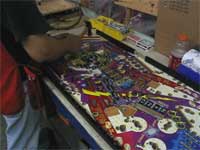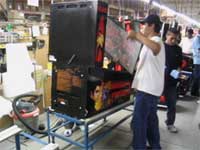
PINBALL EXPO 2004
|
November 4, 2004 There are many pinball shows around the world. Some have more games, some have bigger tournaments but only Expo brings everything together under one roof and this was its twentieth year But it all starts outside. For most Expo visitors, their first taste of the show is the traditional bus trip and the tour of the Stern factory to see the current game in production.
The organisation of this introduction to Expo is, and always has been shambolic. The buses never leave on time and then they all leave at once. There's a long wait when you arrive before you can get off the bus and then a long wait to get into the factory. A twenty minute tour of the factory is stretched to over two and a half hours. Stretched so much you risk missing the start of the seminars at 11am when you return.
So, here's my suggestion to improve things. Stagger the bus departure times by fifteen minutes. State when they leave and when they return and stick to those times. That way, people can choose the best time for them and if they just miss one or it's full, you know it's only fifteen minutes to the next one. It also means people arrive at Stern in groups rather than all at once which makes things easier for them to manage and it's Stern's goodwill that makes this important part of the Expo experience possible. This year, the traditional Bumper Blast welcome meeting was held the previous evening instead of the usual Thursday lunchtime. This was presumably to give visitors something to do the evening before the show started but in reality there's enough to do and parties to visit, so I'd suggest moving it back to Thursday but holding it in the morning; before, during and after the factory tour. Provide coffee, donuts or other snacks and give people something to do while waiting to go or when they return, before the seminars start. So with the first rant of this report out of the way let's get on with the good stuff. Aware of the growing discontent at the waiting, Gary Stern spoke to the crowds both on the buses and in the factory parking lot.
Sadly, he would be flying to some trade shows in Europe and wouldn't be at Expo so this was his chance to promote the company's latest game - Elvis. Entering the factory you come immediately to the wiring department.
Newcomers are amazed by the number of people working at the factory and the lack of automation. If there's a job to be done, someone is employed to do it. Each new game has its wiring diagram which is stuck on a peg board and pegs inserted to define the wire routes and termination points. The wires are then bundled together to form a loom.
Some connectors are push-fitted on the peg board anything involving soldering happens a little later on.
The looms have their Molex pins and lamp connectors soldered on, again all done by hand. The Molex pins are then inserted into their housings.
The loom is checked by plugging it into a test rig.
While the loom is coming together, deeper inside the building various assemblies are made. This is the Elvis drop target bank. Again, everything is hand built and loaded into boxes until they're needed for production or spares.
There are many component parts in a pinball game and one of them is being prepared in another part of the factory.
The pre-printed playfields arrive but they are a long way from being ready to accept parts. First of all they must face the press. No, not us, this press...
Those pins press into the playfield making indentations which can be used as screw holes. For larger holes you need a drill and a way to know where to drill. So a metal template is laid over the playfield and holes are drilled through the holes in the sheet.
The playfield then starts its journey, adding more parts at each stage until a completed playfield rolls off the end of the line.
But let's not forget the largest parts of a pinball machine - the cabinet and backbox.
The backbox has its own line where the circuit boards and fluorescent tube are fitted before they're connected to the wiring loom. And don't worry about running out of cabinets, they've got a few in stock.
The cabinets are drilled and fitted out with the siderails, transformer and speaker.
When all the parts are component parts of the game are brought together the game is cleaned, the glass and backglass added and made ready for packing.
It is then put into a cardboard box and loaded into a container to await shipping.
Before we leave , is this the world's worst job?
But Stern weren't finished yet. On the way out we were given shrunken head toys from Ripley's Believe It Or Not! and shown a couple of text fixtures designed to determine the longevity of different parts in the game.
One animated Elvis' legs to see when they eventually broke and the other fired balls at posts continuously for around twenty seconds
Then it was back to the Ramada for the seminars which we'll cover in the next part of our Expo report.
© Pinball News 2004 |






















